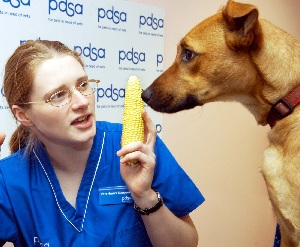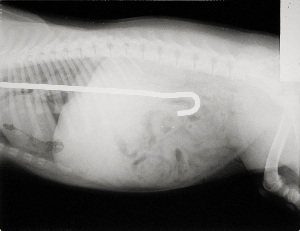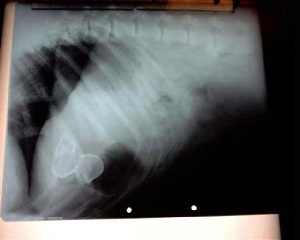|
Pets eating unusual objects

PDSA has a
varied case book of pets that have swallowed unusual objects and can
now add a tent peg to this list following the case of 3-month-old
Staffordshire Bull Terrier, Disa, who swallowed a 27cm tent peg!

Here’s the charity’s
list of the top 10 most common foreign bodies which pets have got
their teeth into!
1. Dummy/teat
2. Stones
3. Bones
4. Toys
5. Balls
6. Corn on the cob cores
7. Miscellaneous rubber objects e.g. household waste, bits of rubber
toys
8. Fabric or clothing – socks are the most common, but PDSA vets
have also seen bras and knickers too!
9. Linear foreign bodies such as – needle and thread in cats, tape
cassette in dogs.
10. Plastic bags
Other bizarre items
found in pet’s tummies include packs of condoms, rubber ducks, and
corks! But what is it that causes pets to swallow these things?

There is actually a
scientific name for this type of behaviour – pica. This condition
can be an instinctive preference for a certain substance or possibly
the result of a dietary deficiency. Dogs use their mouth to
explore objects as well as to eat. Sometimes the 2 functions get
confused and a dog will eat an object by mistake, even though it had
only meant to investigate it. If an owner tries to recover an object
being played with, the dog may run away with the object still in its
mouth, or will growl.
It is very important to stop dogs eating inappropriate items, such
as stones, as they can cause serious illness if the objects become
lodged in the intestine. Symptoms that may indicate your pet has
something lodged in its intestines include, vomiting, abdominal
pain, restlessness, abdominal distension, dehydration, lack of or no
appetite, low body temperature, congested mucous membranes which
appear reddened and blood shot and elevated heart rate.
Cats also display pica, and wool eating is one form of this
behaviour. This may be an inherited condition, as it appears mainly
in Siamese and Siamese crosses, but other breeds are also affected.
The reasons behind this behaviour are unclear. Wool eating is
not the only example of unusual things that cats have eaten, other
items include carrier bags, babies’ dummies and electrical cables.
Cats with pica should be monitored very closely as other dangerous
items may attract their attention. For example, owners should ensure
that any electrical wires are safely covered with plastic conduit or
fixed to the skirting board.
There are various treatment options to help stop pets eating
inappropriate items eg:- distracting a pet with a ball or loud
noise, making the item taste unpleasant using something that is safe
yet tastes unpleasant, and keeping dogs on a lead when they are near
to tempting objects.
The best overall advice for pica is prevention, but if the problem
persists, contact your vet for advice. |
Wildlife Trusts Welcome £1 million SOS Success
THE refrain,
"Can we save the Red Squirrel? Yes we can!" is echoing
around the Wildlife Trusts of the North of England and their
partners this week.
The Heritage Lottery Fund have just announced they are to help fund
a major new initiative aimed at raising awareness about the plight
of our native Red Squirrels, which are now extinct in most of
mainland England, and promoting new conservation measures to save
this
threatened species which is so close to the nation's heart.
The "Save Our Squirrels" project has been awarded £626,000 by
the Heritage Lottery Fund as part of a £1.1 million initiative to be
managed and co-ordinated by Northumberland Wildlife Trust on behalf
of the Red Alert North England (RANEng) partnership.
With confirmation that funding is now in place, a team of 7 Red
Squirrel Officers will be deployed from the Mersey to the Tyne and
beyond to implement this project that will drive forward delivery of
the national Red Squirrel conservation strategy which was launched
last November.
Welcoming the announcement, on behalf of the RANEng Steering Group,
Northumberland Wildlife Trust's Chief Executive, Mike Pratt
commented:- "This is great news for all concerned with the
conservation of this iconic animal from England's woodlands - the
real "Squirrel Nutkin"! We will work with our partner Trusts
in Lancashire & North Merseyside, Cumbria and Yorkshire to engage
everyone in this work, and with landowners and the public to
implement conservation measures in the 16 designated Red Squirrel
Refuges and surrounding buffer zones.
Organisations including Red Alert North West and Red Alert North
East have been working for years toward this end and this project
will finally bring the North of England wide co-ordination of
resources and action needed. In particular, it will enable us to
involve local communities and have a wider educational role as well
as carry out more in-depth species conservation work.
Many more people will get closer to this magical creature through
the project, possibly for the first time, through the Trusts' People
and Wildlife programmes. We also believe the project will fuel
nature tourism opportunities in the North.
The project has been recognised nationally as one of the most
important new initiatives promoting wildlife diversity and the grant
is one of the largest ever made for species conservation."
Government Forestry Minister, Jim Knight MP, said today:- "Red
Squirrels are a cherished but threatened part of our biodiversity in
England. I'm very pleased to learn that this significant new funding
has been secured by this partnership project. It is a key step in
sustaining the remaining populations of Red Squirrels in the Red
Squirrel reserves in northern England and it will enable more people
to enjoy these beautiful animals."
Fiona Robertson, Red Squirrel Officer for the Lancashire Wildlife
Trust, added:- "This funding will allow us to employ a People
and Wildlife Officer in order to encourage people's enjoyment of Red
Squirrels on the Sefton Coast and further support the active
involvement of the local community and schools throughout Merseyside
and West Lancashire in Red Squirrel conservation. We also intend to
create a new viewing site at Lifeboat Road, Formby, in partnership
with Sefton Council's Coast and Countryside Service, to provide an
additional place for the public to experience close encounters with
Red Squirrels."
<<PUT PICTURE OF
LIFEBOAT ROAD, AND RED SQUIRRELS HERE>>
YOU MAY NEED TO
TAKE THEM PATRICK
Jazz at the Palm House
 ON
23 April 2006 see Just East
Jazz play live
at
the
Palm House, Sefton Park, Liverpool.
Full bar and refreshments on
sale, part cafe style seating. Limited seating capacity so buy
your tickets now to avoid disappointment.
Doors open at 6:30pm for a 7.30pm start.
Unreserved tickets at:- £14.50 ON
23 April 2006 see Just East
Jazz play live
at
the
Palm House, Sefton Park, Liverpool.
Full bar and refreshments on
sale, part cafe style seating. Limited seating capacity so buy
your tickets now to avoid disappointment.
Doors open at 6:30pm for a 7.30pm start.
Unreserved tickets at:- £14.50

To book pop in to the Palm
House in
Sefton
Park or phone them on:- 0151
709 4988 or 0151 707 1002.
You can also get booking information
 via
going to:-
www.palmhouse.org.uk via
going to:-
www.palmhouse.org.uk
More information
about the event can be found at:-
www.Liverpooljazz.org

|

